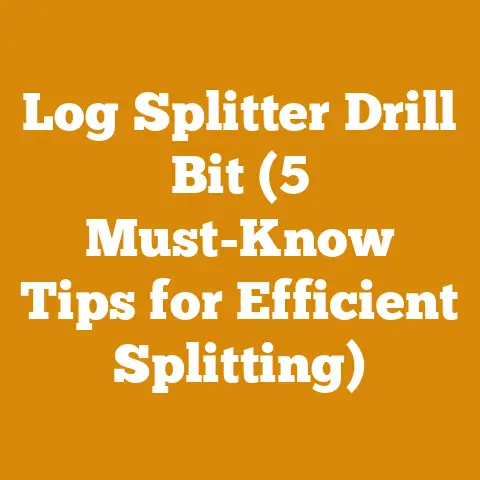Can You Burn Eucalyptus Wood? (5 Tips for Faster Seasoning)
Let’s face it, who doesn’t love the idea of a crackling fire on a chilly evening? The warmth, the ambiance, the primal connection to something ancient and comforting. But getting there – turning a fallen tree into cozy heat – can sometimes feel like a Herculean task. And when you throw eucalyptus into the mix, the question, “Can you even burn eucalyptus wood?” becomes a serious one.
I’ve spent years wrestling with logs, splitting wood, and coaxing reluctant flames from all sorts of species. I’ve learned a thing or two about the joys and frustrations of firewood, and eucalyptus has definitely presented its own unique set of challenges and rewards. So, let’s dive in and explore the world of eucalyptus firewood, debunking myths, sharing practical tips, and ultimately, helping you decide if it’s the right choice for your hearth.
Can You Burn Eucalyptus Wood? Unveiling the Truth
The short answer? Yes, you absolutely can burn eucalyptus wood. However, it’s not quite as straightforward as tossing in a few oak logs. Eucalyptus has some distinct characteristics that demand respect and a bit of know-how.
The Eucalyptus Enigma: Understanding Its Properties
Eucalyptus is a diverse genus of trees, boasting over 700 different species. Originating primarily from Australia, it has been introduced to various parts of the world, from California to South Africa, for its fast growth and diverse applications, including timber, essential oils, and even honey production. This wide variety means that burning characteristics can differ significantly depending on the specific eucalyptus species you’re dealing with.
Here’s a breakdown of some key factors:
- Density: Eucalyptus generally ranks high in density, meaning it packs a lot of wood into a small space. Denser woods typically burn hotter and longer. Some species, like Eucalyptus sideroxylon (Red Ironbark), are exceptionally dense, rivaling hardwoods like oak.
- Oil Content: Eucalyptus is famous for its aromatic oils. These oils contribute to its distinctive smell and, importantly, its flammability. While the oils can help get the fire going, they also mean that eucalyptus can be prone to sparking and popping, requiring extra caution.
- Moisture Content: Freshly cut eucalyptus is notoriously high in moisture. This is a major hurdle to overcome. I’ve seen freshly felled eucalyptus that feels almost saturated. This high moisture content makes it difficult to ignite and causes it to burn inefficiently, producing excessive smoke.
- Creosote Production: All wood, when burned incompletely, produces creosote, a tarry substance that can build up in your chimney and pose a fire hazard. Eucalyptus, due to its oil content, can potentially produce more creosote than some other hardwoods if not properly seasoned.
Eucalyptus vs. Other Firewood: A Comparative Look
To put things in perspective, let’s compare eucalyptus to some other common firewood species:
| Wood Species | Density (lbs/ft³) | BTU/Cord (approx.) | Seasoning Time (Months) | Sparking/Popping | Creosote Potential |
|---|---|---|---|---|---|
| Eucalyptus | 45-60 | 20-35 million | 6-18 | High | Moderate to High |
| Oak | 45-55 | 24-30 million | 6-12 | Low | Moderate |
| Maple | 35-45 | 20-25 million | 6-9 | Low | Moderate |
| Pine | 25-35 | 15-20 million | 3-6 | Moderate | High |
| Douglas Fir | 30-35 | 20-25 million | 3-6 | Moderate | High |
Note: These are approximate values and can vary depending on the specific species and growing conditions.
As you can see, eucalyptus can pack a serious heat punch, comparable to oak in terms of BTU output. However, the longer seasoning time and potential for sparking are important considerations.
5 Tips for Faster Eucalyptus Seasoning: From Green to Grand
The key to successfully burning eucalyptus lies in proper seasoning. Rushing this process is a recipe for smoky, inefficient fires and potential chimney problems. Here are my top 5 tips for accelerating eucalyptus seasoning:
1. The Power of the Split: Smaller is Better
This is perhaps the most crucial step. Eucalyptus, with its dense structure, holds onto moisture like a sponge. Splitting the wood exposes more surface area to the air, dramatically speeding up the drying process.
- Why it works: Think of it like this: imagine trying to dry a whole orange versus drying orange slices. The slices will dry much faster because the moisture has less distance to travel to escape.
- My Experience: I once tried seasoning some eucalyptus rounds without splitting them. After a year, they were still stubbornly damp in the center. Splitting them into smaller pieces made a world of difference.
- Practical Tip: Aim for splits that are no more than 6 inches in diameter. Smaller splits will dry even faster, especially in humid climates. Use a good quality splitting axe or hydraulic splitter for efficient processing. I prefer a splitting axe for smaller quantities because it gives me a good workout.
2. Location, Location, Location: Optimizing Airflow
Where you stack your wood is just as important as how you split it. You need to create an environment that promotes maximum airflow.
- Why it works: Airflow carries away the moisture evaporating from the wood. Think of it like a clothes dryer – it wouldn’t work very well if the vent was blocked.
- My Experience: I initially stacked my eucalyptus wood against a solid fence, thinking it would protect it from the rain. Big mistake! The lack of airflow trapped moisture, and the wood seasoned very slowly.
- Practical Tips:
- Elevate the wood: Use pallets, 2x4s, or purpose-built wood racks to keep the wood off the ground. This prevents moisture from wicking up from the soil.
- Stack in a single row: Avoid stacking the wood in large, dense piles. A single row allows air to circulate more freely around each piece.
- Orient to prevailing winds: Position your woodpile so that it’s exposed to the prevailing winds in your area. This will help to whisk away moisture.
- Sun Exposure: If possible, choose a location that receives plenty of sunlight. Sunlight helps to warm the wood and accelerate evaporation.
3. The Shelter Dilemma: To Cover or Not to Cover?
This is a hotly debated topic in the firewood world. The answer depends on your climate.
- The Argument for Covering: In rainy climates, a cover can protect the wood from becoming re-saturated with rain.
- The Argument Against Covering: A cover can trap moisture and reduce airflow if not properly managed.
- My Experience: I live in an area with moderate rainfall. I’ve found that covering the top of the woodpile with a tarp, while leaving the sides open for ventilation, works best.
- Practical Tips:
- Use a tarp: A waterproof tarp is ideal for protecting the wood from rain and snow.
- Angle the tarp: Make sure the tarp is angled to allow water to run off easily.
- Leave the sides open: Allow for ample airflow by leaving the sides of the woodpile uncovered.
- Consider a woodshed: If you have the space and resources, a woodshed provides excellent protection from the elements while still allowing for good ventilation.
4. The Waiting Game: Patience is a Virtue (But We Can Speed it Up)
Even with the best techniques, seasoning eucalyptus takes time. However, there are ways to monitor the process and determine when your wood is ready to burn.
- Moisture Meters: Invest in a moisture meter. These handy devices measure the moisture content of the wood. Ideally, you want the moisture content to be below 20% before burning. I find that a moisture content between 15-18% is ideal.
- The “Check” Test: Look for checks (cracks) in the end grain of the wood. These cracks indicate that the wood is drying out.
- The “Sound” Test: Bang two pieces of wood together. Seasoned wood will produce a hollow, ringing sound, while unseasoned wood will sound dull and thudding.
- The “Weight” Test: Seasoned wood will be noticeably lighter than unseasoned wood.
- My Experience: I rely heavily on my moisture meter. It takes the guesswork out of the seasoning process. I’ve also learned to recognize the sound of seasoned wood – it’s a satisfying ring that tells me I’m ready to fire up the stove.
- Data Point: Studies have shown that properly seasoned wood can burn up to 50% more efficiently than unseasoned wood.
5. The Species Factor: Knowing Your Eucalyptus
As I mentioned earlier, there are hundreds of eucalyptus species, and their burning characteristics can vary. Identifying the specific species you’re dealing with can help you estimate seasoning time and anticipate potential challenges.
- Resources: Consult local forestry agencies, arborists, or experienced firewood vendors for help identifying eucalyptus species in your area.
- Online Databases: Online databases like the Wood Database (https://www.wood-database.com/) provide information on the properties of various wood species.
- My Experience: I’ve burned several different eucalyptus species, including Eucalyptus globulus (Blue Gum) and Eucalyptus camaldulensis (River Red Gum). I’ve found that Blue Gum tends to season a bit faster than River Red Gum, but both burn hot and long when properly seasoned.
- Case Study: A local firewood producer I know specializes in eucalyptus. He keeps detailed records of the seasoning times for different species and adjusts his processing methods accordingly. This allows him to consistently deliver high-quality, seasoned eucalyptus firewood to his customers.
Burning Eucalyptus Safely: A Few Words of Caution
While eucalyptus can be a great source of heat, it’s essential to burn it safely.
- Sparking and Popping: Eucalyptus is known for its tendency to spark and pop due to its oil content. Always use a fireplace screen to prevent sparks from escaping and potentially starting a fire.
- Creosote Buildup: As with all firewood, incomplete combustion of eucalyptus can lead to creosote buildup in your chimney. Have your chimney inspected and cleaned regularly by a qualified professional. The Chimney Safety Institute of America (CSIA) recommends annual inspections.
- Ventilation: Ensure adequate ventilation in your home when burning wood. Carbon monoxide is a silent killer. Install carbon monoxide detectors and test them regularly.
- Proper Storage: Store your firewood away from your house to prevent pest infestations and reduce the risk of fire.
Tools of the Trade: Essential Equipment for Eucalyptus Firewood
Having the right tools can make all the difference when processing eucalyptus.
- Chainsaw: A chainsaw is essential for felling trees and cutting logs into manageable lengths. Choose a chainsaw with a powerful engine and a sharp chain. I personally prefer Stihl and Husqvarna chainsaws for their reliability and performance.
- Data Point: According to a study by the National Institute for Occupational Safety and Health (NIOSH), chainsaw-related injuries are a significant concern in the logging industry. Always wear appropriate personal protective equipment (PPE), including a helmet, eye protection, hearing protection, and chaps, when operating a chainsaw.
- Splitting Axe or Maul: A splitting axe or maul is used to split logs into smaller pieces. A maul is heavier and designed for splitting larger, more difficult logs.
- Hydraulic Log Splitter: A hydraulic log splitter can significantly reduce the effort required to split wood, especially if you’re processing large quantities of eucalyptus.
- Wedges: Wedges can be used to help split particularly tough logs.
- Moisture Meter: As mentioned earlier, a moisture meter is essential for determining when your wood is ready to burn.
- Personal Protective Equipment (PPE): Always wear appropriate PPE, including gloves, safety glasses, and sturdy boots, when processing firewood.
The Environmental Impact: Is Burning Eucalyptus Sustainable?
The environmental impact of burning eucalyptus is a complex issue.
- Carbon Neutrality: Burning wood is generally considered to be carbon neutral because the carbon dioxide released during combustion is offset by the carbon dioxide absorbed by the tree during its growth. However, this is only true if the wood is harvested sustainably.
- Sustainable Harvesting: Ensure that the eucalyptus you’re burning comes from a sustainably managed forest. Look for certifications like the Forest Stewardship Council (FSC).
- Air Pollution: Burning wood can contribute to air pollution, particularly in urban areas. Use a modern, EPA-certified wood stove or fireplace insert to minimize emissions.
- Data Point: EPA-certified wood stoves can reduce particulate matter emissions by up to 70% compared to older, non-certified stoves.
- Alternative Uses: Consider alternative uses for eucalyptus wood, such as lumber, mulch, or compost.
My Personal Eucalyptus Firewood Journey: A Story of Learning and Warmth
I remember the first time I tried to burn eucalyptus. I had just moved to a rural area with an abundance of eucalyptus trees. I figured, “Free firewood! What could be better?” I felled a tree, cut it into rounds, and tossed a few pieces into my fireplace. The result was a smoky, sputtering mess that produced more frustration than heat.
That experience taught me a valuable lesson: eucalyptus is not like other firewood. It requires patience, knowledge, and a willingness to learn. Over the years, I’ve experimented with different seasoning techniques, learned to identify various eucalyptus species, and refined my wood-burning practices.
Now, I can confidently say that I enjoy burning eucalyptus. The heat is intense, the smell is invigorating, and the crackling fire provides a comforting ambiance on cold winter nights. It’s a testament to the fact that with the right knowledge and techniques, even the most challenging wood can be transformed into a source of warmth and enjoyment.
Conclusion: Eucalyptus Firewood – A Worthwhile Endeavor?
So, can you burn eucalyptus wood? Absolutely. But it’s not a set-it-and-forget-it kind of firewood. It demands attention to detail, proper seasoning, and a commitment to safety.
If you’re willing to put in the effort, eucalyptus can be a rewarding and sustainable source of heat. Its high density and BTU output make it an excellent choice for cold climates. Just remember to follow my tips for faster seasoning, burn it safely, and respect the unique characteristics of this fascinating wood.
Ultimately, the decision of whether or not to burn eucalyptus is a personal one. Consider your climate, your resources, and your willingness to learn. If you’re up for the challenge, you might just find that eucalyptus is the perfect fuel for your fire. And who knows, maybe you’ll even develop a fondness for its distinctive aroma, just like I have. Happy burning!






